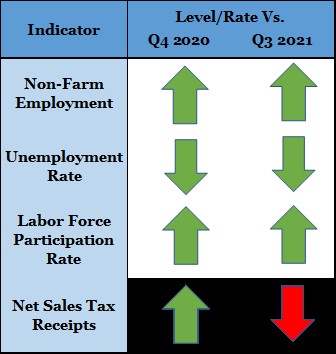PROVIDENCE – Rhode Island’s economic recovery continues to lag the nation despite improvements across several key measures in the fourth quarter of 2021, according to a new report published by the Rhode Island Public Expenditure Council and the Center for Global and Regional Economic Studies at Bryant University.
The Rhode Island Key Performance Indicators Quarterly briefing, published Wednesday, showed an improved overall economic outlook in the fourth quarter compared with the third quarter. This included better quarter-over-quarter labor market metrics in several categories, including a 4,000-job increase in nonfarm employment, a 0.5-percentage-point drop in the unemployment rate and a 0.3-percentage-point rise in the labor force participation rate, the report stated. Net sales tax receipts, an indicator of demand in the economy, decreased by 4.4% compared with the prior quarter.
Wednesday’s report noted two areas where Rhode Island’s recovery has fallen a bit behind, according to the economic data:
- Rhode Island has regained 75% of jobs lost after the onset of the COVID-19 pandemic but remains 22,100 jobs below pre-pandemic levels. The Ocean State has regained jobs slightly faster than the region, which has regained 73.3% of its jobs regained, but slower than the nation, which has gained 82.2% of its pre-pandemic jobs.
- In the third quarter of 2021, Rhode Island registered a second consecutive quarter of growth in its gross domestic product, although its growth rate of 2.2% was lower than that of the U.S. (2.3%) and New England (2.6%). It was also significantly lower compared with the second quarter (7.5%). GDP data from the fourth quarter are not yet available.
“Rhode Islanders continue to return to work in most industry sectors, which is good news for our economy,” said Michael DiBiase, CEO and president of RIPEC. “However, as we know from the Great Recession, Rhode Island’s recovery from economic hard times can be slow and challenging. Seeing the state lag behind the nation should be an early signal that we must do more to support a return to a pre-pandemic economy.”
Some industries fared better than others. Leisure and hospitality experienced the largest increase in employment with 1,300 new jobs. Education and health services and financial services suffered losses while job growth was flat in construction.












